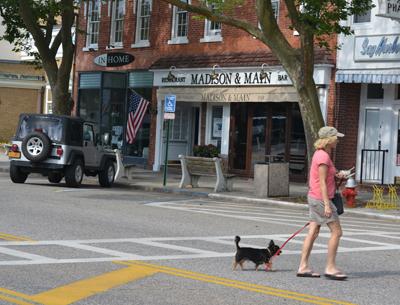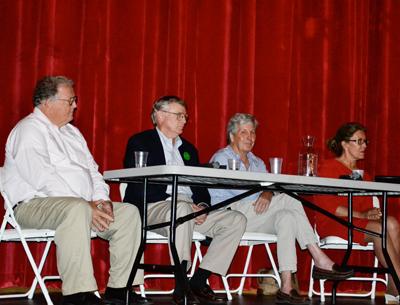Outdoor Dining, Yes and No
Outdoor Dining, Yes and No

The Sag Harbor Village Planning Board approved and expedited an application on Tuesday evening to allow Madison and Main, a new restaurant, tables for dining outside on Main Street. A restaurant across the street, however, Page at 63 Main, was not as fortunate. Its application for a permit to allow outdoor dining behind it was tabled until the next meeting, and the prospects aren’t good.
Neil Slevin, the chairman of the planning board, took issue with the changes to the site planned by Gerard Wawryk, an owner of Page at 63 Main. “Eliminating a driveway is not in the interest of planning,” Mr. Slevin said.
“It is not a driveway,” argued Dennis Downes, Mr. Wawryk’s attorney. “It is simply the rear portion; it is not required.”
“If it walks like a duck and quacks like a duck,” Mr. Slevin said.
“It doesn’t matter what it is called,” said Denise Schoen, the board’s attorney. “Circulation on the site is in your purview.”
Mr. Slevin was concerned about trucks pulling over on Division Street for deliveries. “It is a fiasco when Clare Rose delivers,” he said of the Patchogue beer delivery company.
Mr. Downes argued that most Main Street businesses do not have driveways and accept deliveries via hand trucks.
“I have difficulty approving something that aggravates, even in a minor way, what is already a critical situation,” Mr. Slevin said.
Meg Farrell, an attorney representing nearby Murf’s Backstreet Tavern, also opposed the application, mentioning the possibility of an increase in waste and sanitary flow resulting from more business at Page at 63 Main.
“Sanitary flow has nothing to do with patrons on the site,” Mr. Downes responded. “The number of seats dictate the sanitary flow . . . we are not increasing seating capacity. The seats are moved in or out depending on market conditions.”
The restaurant at present makes use of tables on Main Street that are removed every night, Mr. Downes said, adding that the difference is that the seating proposed for behind the restaurant would be on private property. The restaurant intends to put up fences on both sides of the outdoor dining area, he said, separating it from Murf’s, and there would be a gate for entry at Division Street, which Murf’s faces.
Customers could come in the front door, place an order, and go out back to wait for the order, Mr. Downes said. They would also be able to eat takeout food there, but he clarified that there would be “no food service in the back,” as well as “no music outside, and minimal lighting.”
“We want Page to succeed, but we do have concerns if the party gets too big,” said Gwen Waddington, a co-owner of another neighboring business, the Wharf Shop. Having already dealt with the outdoor bar scene at Murf’s, where people walk out and might drop garbage and occasionally “need to puke somewhere,” she said she applauds the restaurant if it actually establishes a legitimate dining area, but not “if it becomes a big party.”
Larry Perrine, a member of the planning board, worried that it may become so popular that people would be “dying to be back out there in the waiting area.”
When it was time for a motion, Mr. Slevin asked for one but did not receive it. “I’m not making a motion,” he said, citing again his reluctance to promote anything that might slow the flow of traffic on Division Street.
Greg Ferraris abstained because a co-owner of Page at 63 Main, Joseph Traina, was a client of his accounting firm. Jack Tagliasacchi was not present, and was expected to abstain anyway, as he owns another restaurant in the village, Il Capuccino.
The application was tabled until the next meeting, on July 23, when Mr. Perrine and the other board member, Nathan Brown, could decide and perhaps convince Mr. Slevin to change his mind, which would be Mr. Wawryk’s only hope.
Four Sidewalk Tables
Madison and Main’s chef and owner, Eric Miller, had a much easier time getting approval for his application to have four tables on Main Street outside the large French doors he installed when he upgraded the space, which was previously the New Paradise Cafe. The approval came despite opposition from one neighbor and one board member, Mr. Brown, who said the tables might present a safety hazard in the event of an emergency.
After some discussion, Mr. Miller said that Mayor Brian Gilbride had agreed to move two benches from in front of the restaurant so pedestrian traffic wouldn’t be impeded. The application was approved with the stipulation that the benches be moved.
Mr. Perrine suggested that the application be expedited due to the nature of the business and start of the summer.
Mr. Ferraris agreed, saying, “The season starts next weekend, can’t we do anything tonight?”
“That would be my inclination too,” Mr. Slevin said. And so it was.
“It’s a beautiful harbor town, people should be able to have outdoor seating,” Mr. Miller said, pleased with the decision. He also reassured the board that the restaurant would offer fine dining and that “safety is my number-one concern.”









